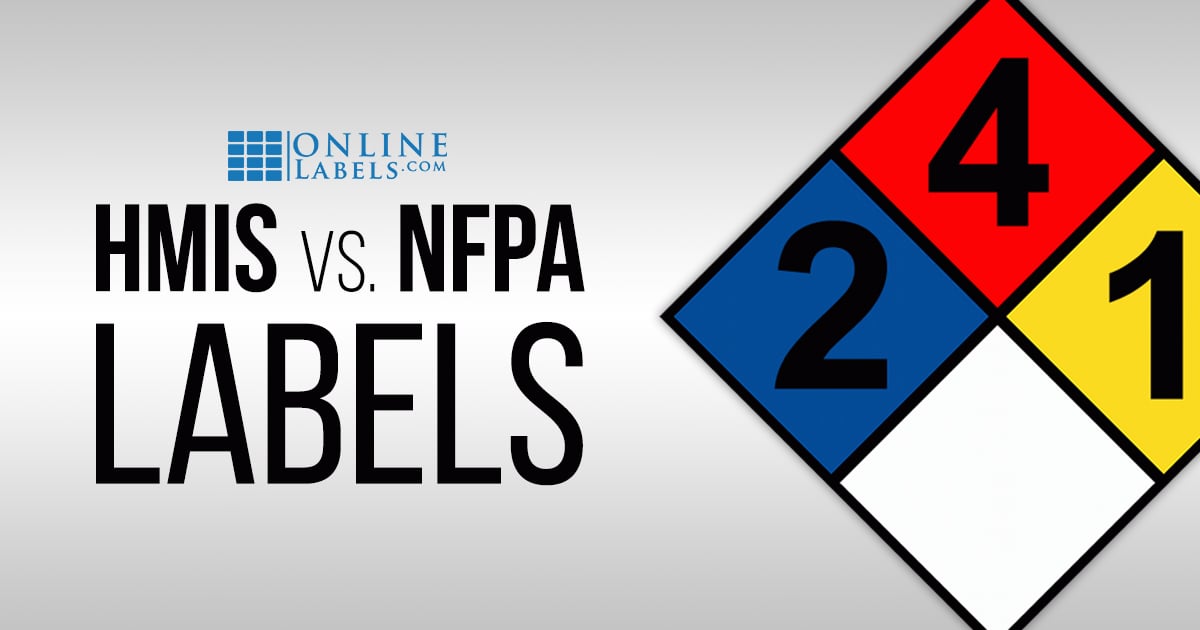HMIS vs NFPA Labels: What's the Difference?

Back in 2012, the U.S. Occupational Safety and Health Administration (OSHA) revised their Hazard Communication Standard (HCS). The HCS ensures chemical safety in the workplace through three labeling systems: Hazardous Materials Identification System (HMIS), National Fire Protection Association (NFPA), and the Globally Harmonized System of Classification and Labelling of Chemicals (GHS).
As labeling experts, we want to talk you through these requirements, helping make your workplace a safe place for your employees to thrive.
What are Hazardous Materials Identification System (HMIS) labels?
HMIS labels were created in 1981 to help employers meet the HCS labeling requirements. They use colors, numbers, and letters in a rectangular table to communicate hazard information to workers.
The colors symbolize:
Blue - Health
The blue section describes health hazards. This bar contains two spaces – one for a number and one for an optional asterisk. The asterisk means that chronic exposure could lead to health problems.
Red - Flammability
The red section relates to the flammability and combustibility of the contained substance. It ranges from 0 (materials will not burn) to 4 (materials may ignite spontaneously with air).
Yellow/Orange - Reactivity/Physical Hazard
An older version of the HMIS label includes a yellow bar to indicate reactivity. Today’s version includes an orange bar to indicate physical hazard. They address explosives, compressed gases, unstable reactives, and more.
White - Personal Protection
The personal protection section is filled in with a letter. Each letter corresponds to a piece of equipment that chemical requires. The safety equipment denotations range from safety glasses to a vapor respirator.
How to implement Hazardous Materials Identification System (HMIS) Labels
We offer a free printable HMIS label template. Fill out each of the colored bars with the appropriate number or letter then download to print.
We recommend using it with our vinyl label material to withstand various conditions and long-term use.
What are National Fire Protection Association (NFPA) labels?
NFPA labels were created in 1960 to help keep workplaces safe during emergency situations. They use colors, numbers, and letters in a diamond-shaped table to communicate chemical hazards, flammability, and reactivity to emergency response workers.
The blue and red sections are the same as HMIS, and indicate health and flammability risk, respectively. The yellow section indicates reactivity, the same as the outdated versions of HMIS. The white section indicates "special hazards," which are communicated using standard shorthand.
They include symbols or acronyms/codes to warn about corrosives and radioactivity, to name a few.
How to implement National Fire Protection Association (NFPA) Labels
We offer a free printable NFPA label template. Download the template or open in Maestro Label Designer. Then, refer to the Safety Data Sheet provided with the chemical to fill out each of the colored diamonds.
We recommend using it with our vinyl label material to withstand various conditions and long-term use.
Similarities & Differences
Both HMIS and NFPA labels serve to provide a safer work environment. However, understanding the differences can help you determine which, if not both, you should implement.
Similarities
Both HMIS and NFPA labels are intended for workplaces that contain hazardous chemicals. Examples of such locations include healthcare facilities, manufacturing facilities, construction sites, gas stations, and more.
They look similar, as both have blue, red, yellow, orange, and white sections. Both also use a 5-number rating scale of 0-4, with 0 being the least hazardous and 4 being the most.
Differences
While they can seem similar in appearance, HMIS and NFPA labels have some important differences, including their primary purpose.
Use the chart below to distinguish HMIS labels from NFPA labels.
| Hazardous Materials Identification System (HMIS) Labels | National Fire Protection Association (NFPA) Labels | |
|---|---|---|
| Intended Audience | Employers and workers who handle and are exposed to hazardous chemicals | Emergency response personnel |
| Appearance | Table | Diamond |
| Content of White Section | Recommended personal protective equipment (PPE) | Other special hazards |
Should you use HMIS, NFPA, or both?
While both HMIS and NFPA keep workers safe, they have slightly different purposes. HMIS is intended for everyday safety, while NFPA is intended for safety during emergency situations, especially fires.
Because of the varied purposes, it can make sense to use both labels in a workplace. However, some employers form a hybrid of the two systems, mixing symbols and standards between the two. This hybrid is not highly recommended, though any labeling system can be used as long as it meets GHS standards and workers are properly trained.
Whichever system you use in your workplace, make sure your employees thoroughly understand the protocols in place and are regularly trained. This will ensure the safest environment possible.
View more of our warning label templates or start shopping our chemical-resistant labels, or go even further with polyester-laminated labels.
This article is meant to be used as a labeling guide, not as an authoritative resource on the latest chemical safety regulations. At the time of publication (August 2018), the information mentioned above is compliant with state and federal laws. Please be sure to check government databases for updates or revisions as regulations can change frequently. We are not responsible or liable for any actions taken as a result of using the content or resources listed above.
Frequently Asked Questions
1. How do I decide whether to use HMIS or NFPA labels (or both)?
Use NFPA 704 for emergency-response signage: tanks, doors, outside buildings, and first responder access. On the other hand, HMIS are used for day-to-day worker safety in plant chemical containers, particularly for employees who regularly handle chemicals. You may choose both if your situation requires it, but ensure that everyone is trained on which system is used for which purpose.
2. My SDS supplier switched to the Globally Harmonized System of Classification and Labelling of Chemicals (GHS) format. Do I need to stop using HMIS or NFPA labels?
Not necessarily. You can keep using HMIS or NFPA as long as it's consistent with your GHS/Hazcom program. However, you may want to consider evaluating whether using a single, consistent system (e.g., GHS style) across your facility would reduce confusion.
3. My team is accustomed to using one system (say, HMIS), but Emergency Response requires NFPA diamonds to be posted. How do I manage both?
Create a plan that designates zones: for worker chemical handling, use HMIS; for building/tank signage for firefighters, use NFPA. Document this clearly in your hazard communication plan and include it in training for everyone in your team.
4. What’s the very next operational step after reading this article?
Pick one area of your facility (e.g., secondary containers in a storage room) and perform a label check. This means reviewing if current labels use HMIS or NFPA, verifying they are in the correct format, confirming staff know how to interpret them, and identifying any mislabeled or missing labels. Then plan to roll out changes across the facility.


